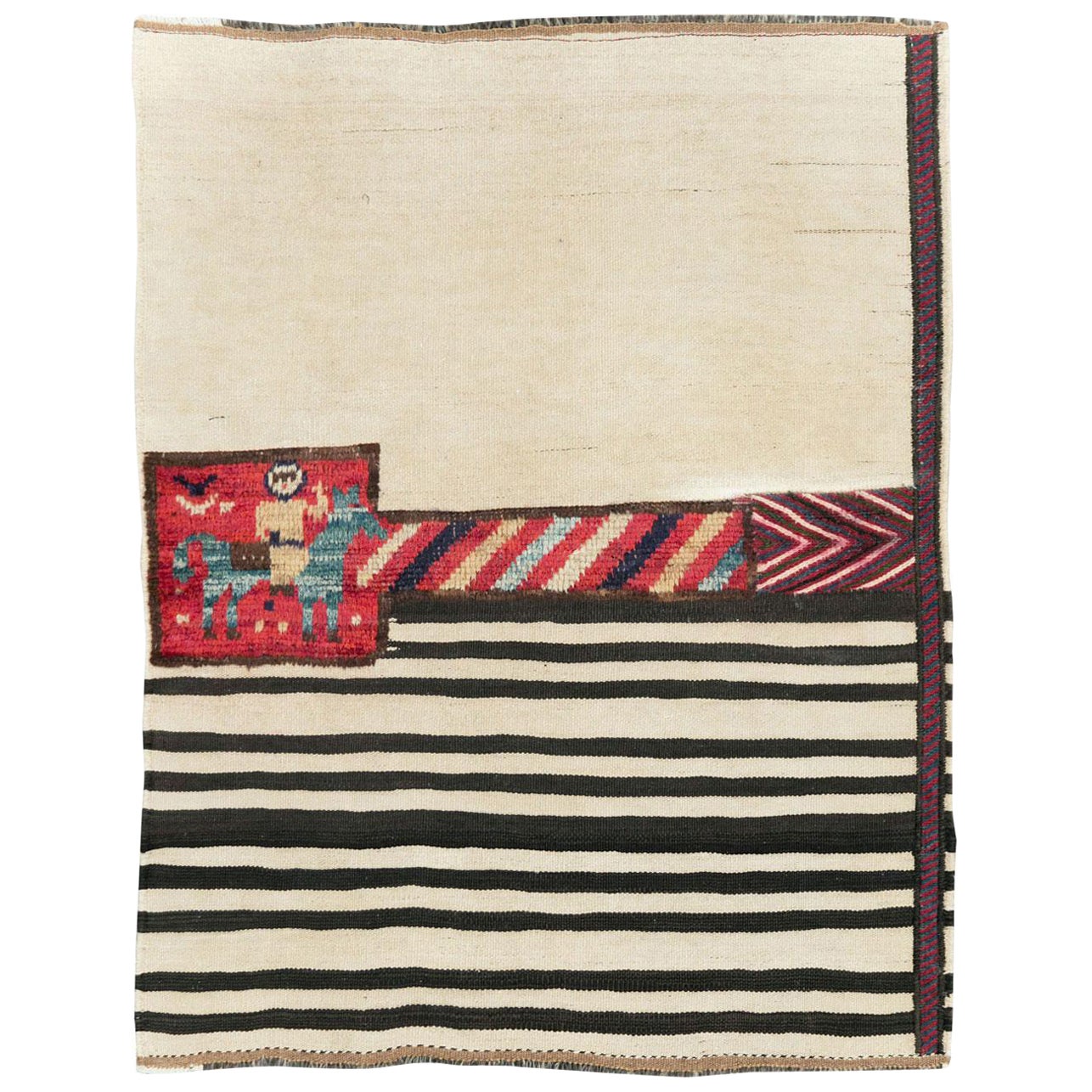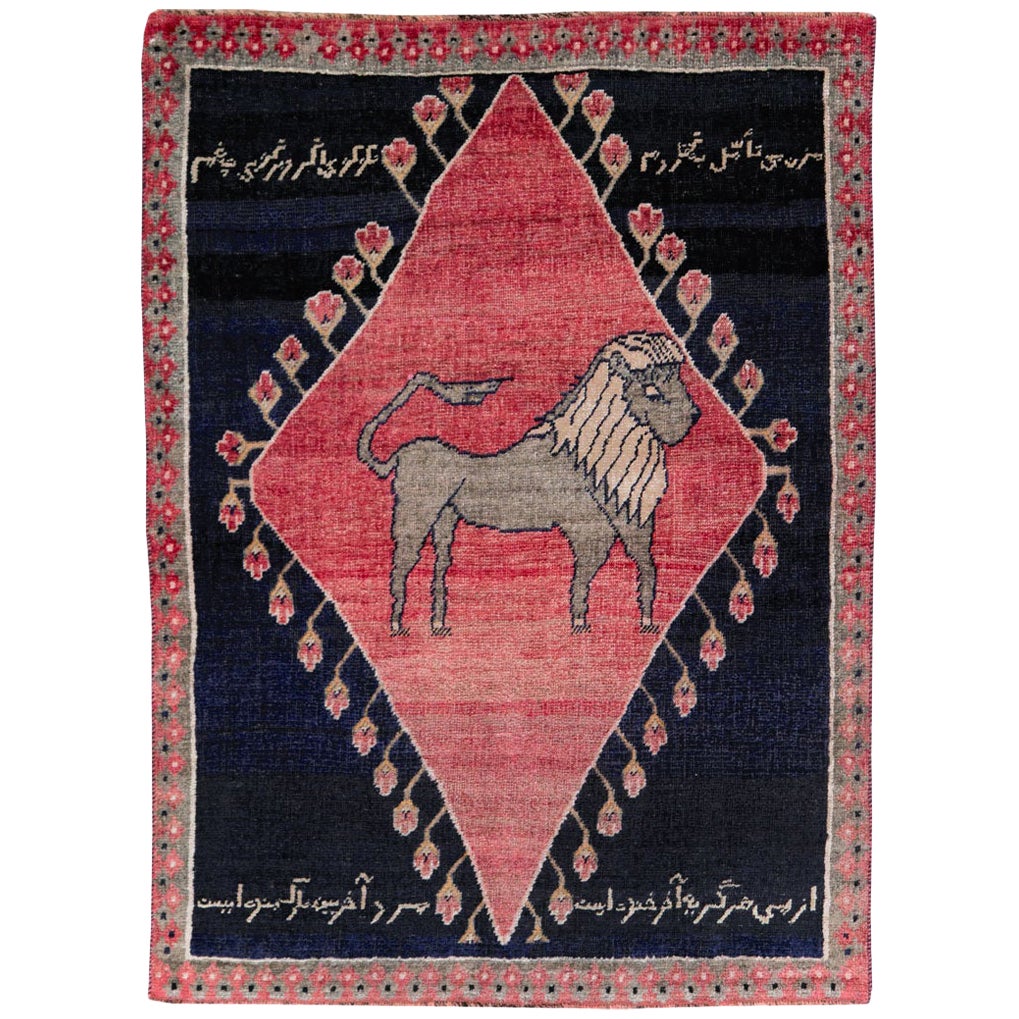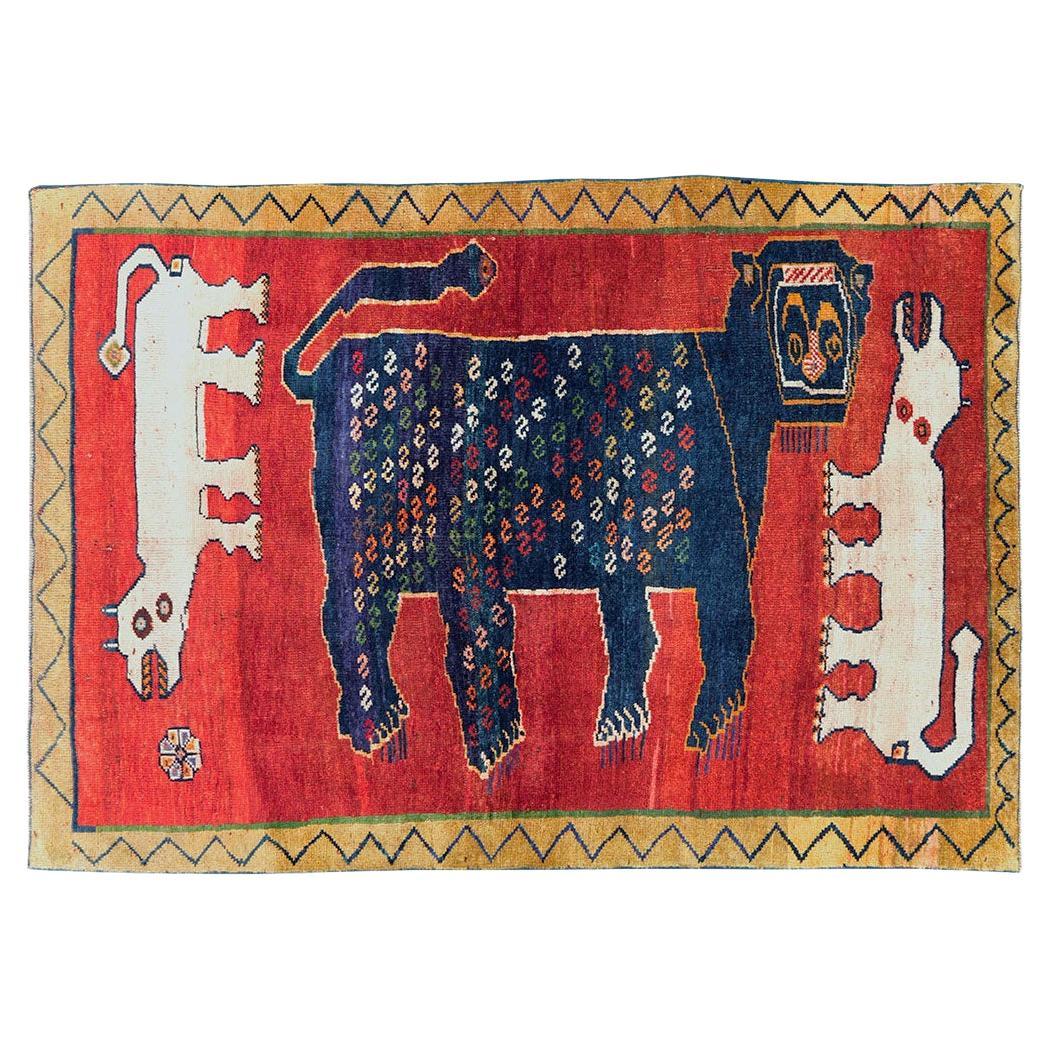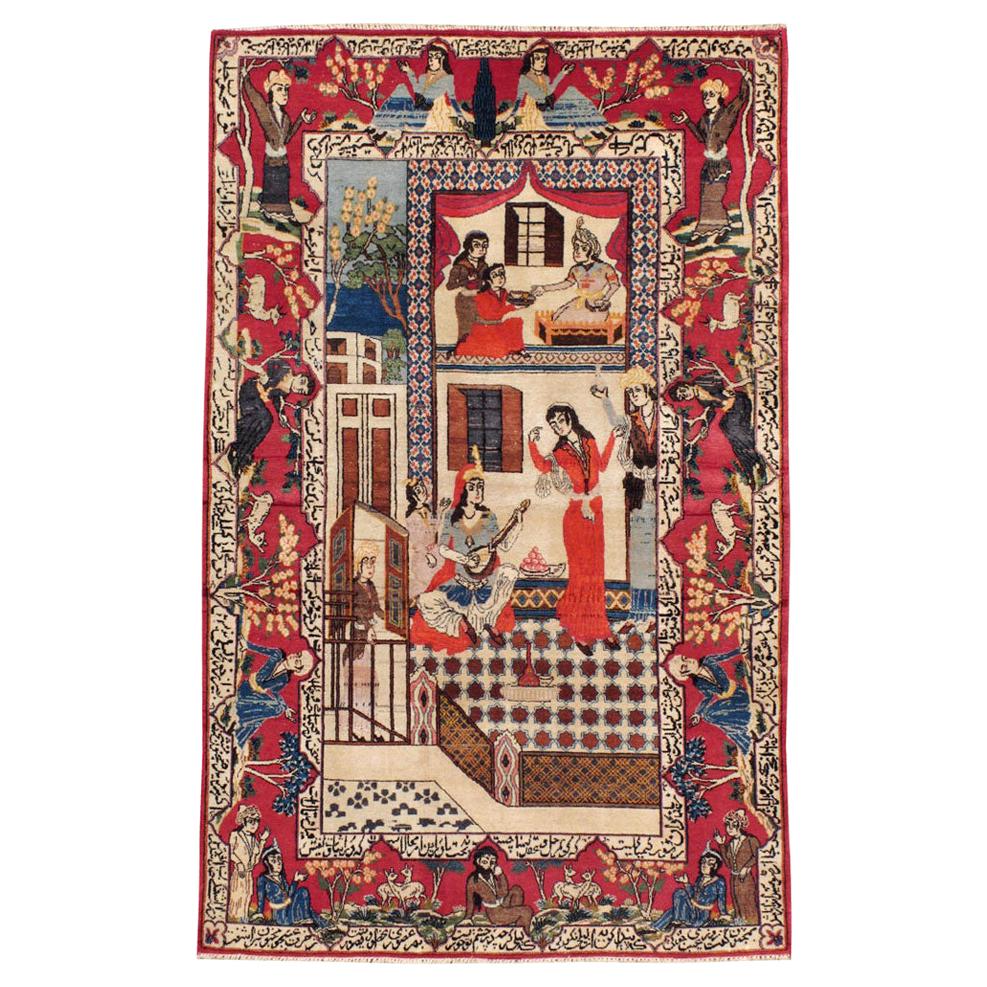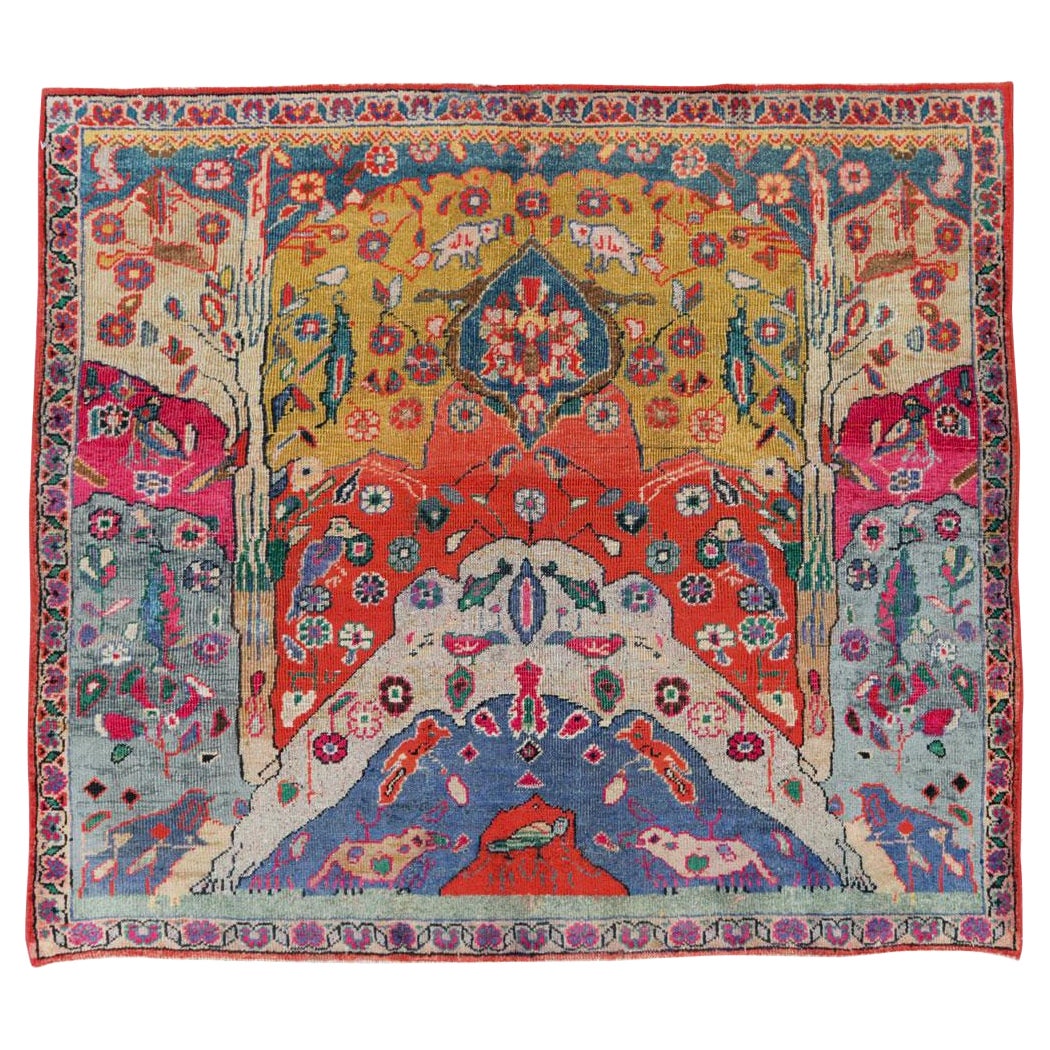Items Similar to Mid-20th Century Handmade Persian Kashan Pictorial Throw Rug
Want more images or videos?
Request additional images or videos from the seller
1 of 8
Mid-20th Century Handmade Persian Kashan Pictorial Throw Rug
About the Item
A vintage Persian Kashan pictorial throw rug handmade during the mid-20th century.
Measures: 3' 7" x 5' 2"
Persian rugs & carpets:
Persia (Iran) is a moderately large country with a very long history and an enormous art/craft/industry built around the handmade carpet. Until the discovery of oil, carpets were the largest Persian export. The craft goes back to ancient times, although the history is more broken than one might expect or desire. The Pazyryk rug dates from the 3rd/4th century B.C.E., but really no carpets before 1500 or so survive in any sort of numbers. Persia is an upland plateau region, semi-arid in many places, verdantly fertile in others, and a perfect base for a pastoral economy. Sheep beget wool and wool begets rugs. Lots of rugs. Almost every province, city, town, village and tribe made or makes rugs with distinctive local characteristics. The rug literature identifies many of these, but thousands of more locales and tribal segments cannot be connected to known examples and vice versa.
There are essentially three (or four) distinct rug genres: the urban workshop formal rug; the village informal type; and the tribal/nomadic really informal kind. A fourth type is the royal or imperial carpet, woven for the Shah in court ateliers. Workshop, village and tribal rugs will be considered in more depth in specialized essays. Persian rugs must be woven in Persia. Being “in the style of….” does not count. On the other hand, the universally high standards of Persian rug weaving have raised the levels of carpet craftsmanship all over the rug belt. Everyone wants to be Persian, at least where rugs are concerned. “Persian rug” and “Oriental rug” used to be synonymous.
Persian rugs come in all grades. From ultra-coarse tribal rugs to incredibly fine silks from Tabriz and planned urban Isfahan pieces. Persian rugs also come in all sizes. From miniature throw rugs to pieces as large as a parking lot. In weaves from 20 knots per square inch to 2000; in wool, silk, combinations thereof, and more modern synthetic and natural fibers. With natural and synthetic dyes. Most Persian weavers are women, in all contexts, but everybody can weave rugs. The Great Persian Carpet Revival began in the 1870s and the industry mushroomed, with many cities, villages, and tribes taking up or radically expanding rug weaving, from an occasional domestic art to a full-time professional industry. For example, Tehran, the capital, developed an industry-oriented exclusively toward very fine, totally designed carpets for the nascent Persian upper classes. A few rugs were exported, but most went to the wealthy. But this industry did not last past the Interwar period. Other cities have been weaving rugs for centuries. Tabriz, an early capital, has been weaving fine rugs since the 16th century, and with an interruption, has a flourishing industry today. Other cities developed carpet industries as demand expanded around 1900. Before then, nothing much in Mashad, after that lots of activity. Towns like Nain and Qum started from nowhere in the ’30s and now have crafts wholly oriented toward high-quality pieces.
Villages all around Persia have contributed their share to the middle market, but 20th century (and later) pressures have pushed them toward higher qualities, more in the urban manner. This quality upgrade has also affected the nomadic, tribal weavers. Once weaving a few rugs for themselves for domestic consumption, they are now almost exclusively weaving for the market and in competition with urban rugs. So, they have moved up in quality and style.
The Persian carpet is not a static kind of thing, and neither is the craft supporting it. Forget the “timeless east”. Rugs are objects of fashion, with innovations beginning at or near the top, and working their way downward as styles become accepted. Because rugs are a worldwide export, foreign influences seep or crash in. Whole new genres are imported. The red “American Sarouk” detached floral spray style was imported around 1920 and quickly became popular all over Iran, in scatters, room sizes, and runners. Not Persian, but “Persian”. Now accepted everywhere. Rugs are viewed in Iran as art objects, and artists everywhere have always taken advantage of innovations in techniques and materials. In Persia, this has meant machine-spun threads and yarns, synthetic dyes, and chemical washing manipulation. Some experiments lead to real improvement, some are unfortunate dead ends. Some patterns are wildly successful, others are quickly discarded. The allover Herati, Mina Khani, Boteh (paisley or cone), and Gol Hennai patterns have proliferated, and the medallion and corners layout in its infinite variety is virtually synonymous with Persian rugs. Persian weavers seem to have invented all these and more. Today, very finely woven photographic pictorials are fashionable. Who knows if this innovation will last?
A basically semi-desert land needs color, has to have color in its furnishings and household accouterments. Persian rugs are all about color. All types revel in true color: saturated reds, deep blues, salmon, sky blue, cerulean, yellows from mustard to lemon, near black, cream and ecru and ivory, greens from teal to turquoise. From the Orient comes light, and light means color. A real, genuine Persian rug is richly, complexly colored. Maybe too rich. The carpets of the Chahar Mahal (“Bakhtiari”) area are just too colorful, too saturated for the American market. But they go over just fine in Persia. No blah rugs there. Current American decorating trends have shied away from color, complexity, and boldness. Whether these are “coming back” is a question. They have never gone away in authentic Persian rugs.
A tour of the country shows urban weaving centers around the border edge, with a central spine; village weavers in the countryside surrounding the cities; and tribal weavers filling the blank spots almost everywhere. Some towns have been continuously active for centuries, like Kerman; some with interruptions like Isfahan, Kashan, or Tabriz; and some are relative newcomers like Qum and Nain. The picture is incomplete and much of the 18th and 19th centuries have been long ignored. There are large gaps with no extant specimens. But also, discoveries of previously ignored tribal and village weaving keep coming. New types get explored and the picture fills in. Whatever story you believe, it is probably only a fraction of the rich history of the Persian carpet.
About the Seller
5.0
Platinum Seller
These expertly vetted sellers are 1stDibs' most experienced sellers and are rated highest by our customers.
Established in 1989
1stDibs seller since 2009
561 sales on 1stDibs
Typical response time: 1 hour
- ShippingRetrieving quote...Ships From: New York, NY
- Return PolicyA return for this item may be initiated within 3 days of delivery.
More From This SellerView All
- Mid-20th Century Handmade Persian Pictorial Flatweave Kilim Throw RugLocated in New York, NYA vintage Persian pictorial flatweave Kilim throw rug handmade during the mid-20th century. Measures: 3' 6" x 4' 6".Category
Mid-20th Century Persian Folk Art Persian Rugs
MaterialsWool
- Mid-20th Century Handmade Persian Kurd Pictorial Lion Throw RugLocated in New York, NYA vintage Persian Kurd throw rug handmade during the mid-20th century with a folk pictorial depiction of a lion. Measures: 3' 6" x 4' 9" P...Category
Mid-20th Century Persian Folk Art Persian Rugs
MaterialsWool
- Mid-20th Century Handmade Persian Pictorial Shiraz Throw RugLocated in New York, NYA vintage Persian pictorial Shiraz throw rug handmade during the mid-20th century. Measures: 3' 9" x 5 ' 4".Category
Mid-20th Century Persian Tribal Persian Rugs
MaterialsWool
- Mid-20th Century Handmade Persian Kashan Pictorial Accent Rug, circa 1940Located in New York, NYA vintage Persian Kashan pictorial accent rug handmade during the mid-20th century. Measures: 4' 3" x 6' 9".Category
Mid-20th Century Persian Folk Art Persian Rugs
MaterialsWool
- Early 20th Century Handmade Persian Malayer Pictorial Throw RugLocated in New York, NYAn antique Persian Malayer pictorial throw rug handmade during the early 20th century. Measures: 3' 6" x 4' 9" Persian Rugs & Carpets: Persia (Iran) is a moderately large coun...Category
Early 20th Century Persian Rustic Persian Rugs
MaterialsWool
- Colorful Mid-20th Century Handmade Persian Pictorial Tabriz Square Throw RugLocated in New York, NYA vintage Persian Tabriz throw rug in square format handmade during the mid-20th century with a colorful pictorial design. Measures: 3' 1" x 3' 6".Category
Mid-20th Century Persian Bohemian Persian Rugs
MaterialsWool
You May Also Like
- Mid-20th Century Red Brown Handmade Traditional Persian Malayer RugLocated in New York, NYVintage Persian Malayer rug in reds and brown, circa 1940. Measures: 4' x 6'3''.Category
20th Century Persian Country Persian Rugs
MaterialsWool
- Mid 20th Century Hand Woven Persian Bashir RugLocated in Vero Beach, FLMid 20th century hand woven Persian Bashir rug. The circa 1950 Persian Bashir Zili Sultan Rug is hand woven with silk warp. It is very finely and distin...Category
Mid-20th Century Afghan Other Persian Rugs
MaterialsSilk
- 20th Century Antique Persian Heriz 7x9 Brown Handmade Area RugBy Ashly Fine Rugs 1Located in Houston, TXAshly Fine Rugs presents an original Antique Persian Heriz area rug. Made with all vegetable-dyed, handspun wool and entirely handwoven. The pile of the rug is 1/4" and has distresse...Category
Vintage 1930s Persian Heriz Serapi Persian Rugs
MaterialsWool
- Late 20th Century Persian Nain RugLocated in Rio Vista, CAFantastic example of a Classic Persian Nain rug featuring a densely knotted wool with silk and a cotton warp. The wool pile is dazzling with topaz blue hues and subtle white highligh...Category
Late 20th Century Persian Tabriz Persian Rugs
MaterialsCotton, Wool
- Traditional Persian Ferehan 20th Century RugLocated in New York, NYClassic Herati design Persian Malayer gallery rug. Ivory field, with accents in green, mustard, blue, brown, terracotta. Measures: 5'1" x 9'7".Category
Early 20th Century Persian Tabriz Persian Rugs
MaterialsWool
- 20th Century Antique Persian Mahal 4x6 Brown & Rust Handmade Area RugBy Ashly Fine Rugs 2Located in Houston, TXAshly Fine Rugs presents a 1930s Antique Persian Mahal 4 x 6 handmade area rug #1142800. This beautiful Antique Persian rug is in good to...Category
Vintage 1920s Persian Sultanabad Persian Rugs
MaterialsWool
Recently Viewed
View AllMore Ways To Browse
Mid Century Rug Yellow
Midcentury Corner Light
Mid Century Colorful Rug
Square Midcentury Rugs
Large Area Rugs Mid Century
Imperial Mid Century
Silk Rug Midcentury
Vintage Yellow Persian Rug
Mid Century Light Blue Color Rugs
Very Large Vintage Persian Rug
Retro Yellow Persian Rug
Bedroom Occasional 20th Century
Kashan Design Persian Rug
Midcentury Area Rug American
Midcentury Fiber Art
Silk Handmade Rug Persian
Handmade Persian Silk Rugs
Persian Silk Rug Handmade
